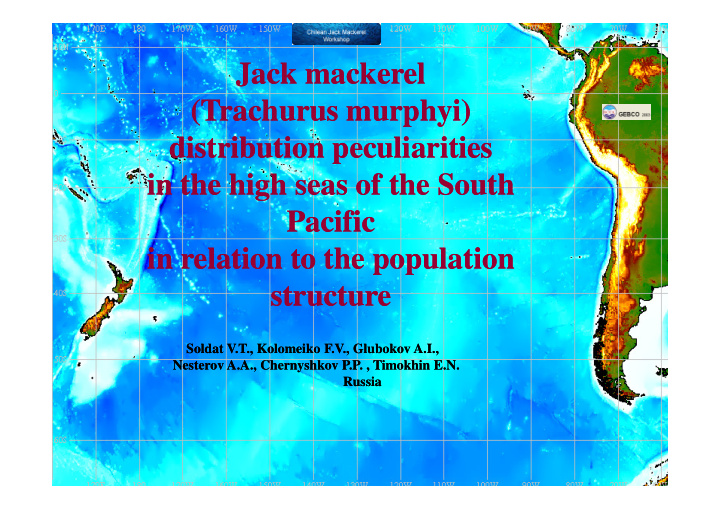



Jack mackerel Jack mackerel (Trachurus murphyi Trachurus murphyi) distribution distribution peculiarities peculiarities in in the high seas the high seas of the South of the South Pacific Pacific in relation to the population in relation to the population in relation to the population in relation to the population structure structure Soldat Soldat V.T., Kolomeiko Kolomeiko F.V., Glubokov Glubokov A A.I., Nesterov Nesterov A.A., Chernyshkov Chernyshkov P.P. , Timokhin Timokhin E.N. Russia Russia
Purposeful study by Russia of jack mackerel in the high seas of the South- East part of the Pacific Ocean (SEPO) (outside the 200-mile zones of Peru and Chile) began in 1978 and was carried out concurrently with the commercial development of this area. In 1977-1978, the Soviet fleet discovered commercial jack mackerel aggregations accessible for trawl fishing. The Soviet research and searching vessels collected the material in that area in 1978-1991 (Chur et al., 1984; Elizarov et al., 1992; А rcos, Grechina, 1994; Kotenev et al., 2006). In 1981-1991, a vast area was investigated in the South-West Pacific Ocean (SWPO) at 30-49°S and 100- 175°W, where commercial aggregations of spawning and foraging jack mackerel occured. The maximum annual jack mackerel catch amounted to 1,17 mln. t in The maximum annual jack mackerel catch amounted to 1,17 mln. t in 1990, and a total catch in the course of 13 years of fishing made up 12,8 mln. t of fish. After 1991 the Russian fleet resumed the fishery in 2003-2005, and a total catch made up 76,9 ths. t. The goal of this paper is to consider jack mackerel distribution peculiarities in different years for the purpose of selecting groupings at the possible population levels.
Available data on jack mackerel in the South Pacific Ocean (1978-1991 & 2002) AtlantNIRO Number Trawl Mass Biological Period of vessel-cruises cards measurements (ind.) analysis (ind.) 1978 10 1232 246400 40876 1979 10 2153 430600 88650 1980 7 1096 219200 51700 1981 11 1482 296400 98022 1982 11 1565 313000 58972 1983 1983 13 13 2013 2013 402600 402600 88380 88380 1984 12 2052 410400 89783 1985 10 2206 441200 100088 1986 12 2462 492400 111523 1987 8 2263 452600 95310 1988 9 2082 416400 96423 1989 9 2050 410000 83033 1990 9 2156 431800 86261 1991 7 1058 211600 48300 2002 1 126 25200 9429 Total 139 25999 5199800 1146750
Jack mackerel was caught during research and searching cruises by B АТМ , R ТМК -S of 5700 and 9260 t GRT, respectively, or by other vessels of similar GRT and capacity. The trawls 120/980 m and 120/1120 m equipped with cod- ends of mesh 37 mm without a cover and 34 mm with a cover made of netting with mesh 68 mm
Jack mackerel distribution in the catches of the Russian research and searching vessels westward of 105°W in quarter I, 1982-1991 (334 trawls, catch in kg).
Jack mackerel distribution in the catches of the Russian research and searching vessels westward of 105°W in quarter II, 1982-1991 (1284 trawls, catch in kg).
Jack mackerel distribution in the catches of the Russian research and searching vessels westward of 105°W in quarter III, 1982-1991 (794 trawls, catch in kg).
Jack mackerel distribution in the catches of the Russian research and searching vessels westward of 105°W in quarter IV, 1982-1991 (470 trawls, catch in kg).
Jack mackerel occurrence at different stages of reproductive cycle in the catches of the Russian vessels (1978-1991) in the South Pacific (30-55°S) by area and month. 100 100 з . д . з . д . 75-105° 105-125° 105-125° W 80 75-105° W 80 60 60 40 40 20 20 75-105° W 0 0 0 0 Quantity, % I II III IV V VI VII VIII IX X XI XII I II III IV V VI VII VIII IX X XI 100 з . д . 125-150° 125-150° W 80 Immature 1 Maturing 60 2 Spawning 3 Spent 40 4 20 0 Month I II III IV V VI VII VIII IX X XI XII
Distribution of jack mackerel spawning individuals by 1°x1° squares in 1982-1991 westward of 105°W (%).
Immature jack mackerel distribution (below 25 cm in length) westward of 105°W according to the data of the Russian searching and commercial vessels for 1978-1991. . 10° 10° 20° 20° 30° 30° 40° 40° 50° 50° ю . ш . ю . ш . 60° 60° в . д . з . д . 170° 180° 170° 160° 150° 140° 130° 120° 110° 100° 90° 80° 70°
Distribution of eddy kinetic energy loads for the SPO area 20-45°S, 75- 180°W (1992-2008) (AVISO, 2008). 180° 170° 160° 150° 140° 130° 120° 110° 100° 90° 80° 70° 20° 30° 40° 50° -1 -0.9 -0.8 -0.7 -0.6 -0.5 -0.4 -0.3 -0.2 -0.1 0
Conclusions • According to Russian studies, jack mackerel aggregations in the period from 1979 to 1991, and in 2002-2003 were recorded in the area at 105°- 175°W year-round. • Zoning by density is traced on the maps of immature and mature jack mackerel distribution in 1979-1991. At least three areas can be singled out including 105-125°W, 125-155°W, 155-175°W. • Mass spawning of jack mackerel was observed in each area. • The conditions for jack mackerel reproduction and their life cycle completion exist all over the area of the southern part of the Pacific Ocean outside the EEZs. Mean annual data on eddy kinetic energy load distribution are indicative • of existence in the South Pacific of the zones with stable characteristics differing from adjacent areas. • The availability of relatively isolated jack mackerel groupings, and specific climatic and oceanological conditions within the limits of singled out zones requires additional studies both of the causes of grouping formation and their isolation degree, and the search of similarity and distinctions between jack mackerel from different areas of the South Pacific in order to determine their population status.
Recommend
More recommend